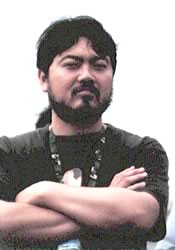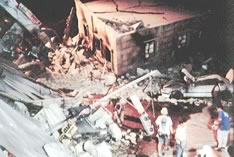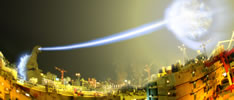|

Special effects director Makoto Kamiya.
|
The
most remarkable aspect of the Godzilla series is the special effects
used to make the destruction of cities and other things look real.
We got Makoto Kamiya, the sixth special-effects director for the
series, to tell us about these special effects.
The
makers of a special-effects film prepare a picture continuity
for each cut. A picture continuity is like a pictorial script,
showing what appears where, and where the camera is positioned.
The filmmakers use this picture continuity in deciding which filming
methods to use. Almost all the shooting takes place inside the
studio, where the filmmakers can create and manipulate a variety
of artificial environments that are not affected by natural conditions
such as light changes, wind, or rain. But scenes in which the
monsters are viewed from below are shot outdoors, where there
are no height limitations and where the real sky can be used as
a background. Scenes with an element of danger, such as big explosions,
are also shot outdoors.
|

Shooting a mountain scene indoors.

Filming a city scene using miniatures.
|
In
the movies, Godzilla is 60 meters (197 feet) tall, but in real
life the "monster" is only 2.2 meters (about 7 feet) in height.
The cityscapes to be destroyed by Godzilla are reproduced in exquisite
detail in miniature. In order to make the miniature world look
real, good lighting is needed; great attention is paid to the
direction, angle, type, and balance of the lights used for filming.
The creation of special effects requires a faster camera speed
and (in order to keep the entire miniature set in focus) more
intense lighting than normal. Furthermore, elements that are not
present during the original shooting but are added afterward,
such as the radioactive flames spewed by Godzilla or the reflective
glow from an explosion, must be lighted to match the other elements
of the scene. All of this makes special-effects filmmaking an
extremely difficult operation.
|

Creating a destroyed city in the studio.
|
A
single second of footage normally consists of 24 frames, so normal
camera speed is 24 frames per second. But to shoot, for example,
an explosion on a miniature set, the filmmakers set the camera
speed about 10 times as fast, at over 240 frames per second. When
this super-fast footage is played at normal speed, an explosion
that lasted only a moment seems to unfold in slow motion and takes
on the character of a large-scale event.
|

Filming a scene where someone falls off a bridge. The picture of the bridge will be superimposed later.
|
So
would it be a good idea to shoot the entire film at 10 times normal
speed? The answer is no. The proper camera speed varies from one
scene to the next. For example, Godzilla is played by an actor
wearing a monster suit that is quite heavy. No matter how fast
the actor tries to move, it is impossible to create the appearance
that the monster is moving quickly. Therefore, the filmmakers
use a slower camera speed to create the illusion that Godzilla
is moving fast. For scenes that include both Godzilla and an explosion,
the two parts are shot separately at different speeds and then
combined into a single scene.
|

A composite image from the battle between Godzilla and Baragon.

This scene of Godzilla spewing heat rays was created using computer
graphics.
|
In
the past, combining the parts was performed by hand, using a machine
called an optical printer. Footage of the background scenery and
footage of Godzilla or human characters were painstakingly put
together, frame by frame. Nowadays, however, digital synthesis
is the standard. Digital synthesis involves using a scanner to
generate digital data from the film, then using a computer to
create the desired image. A machine known as a film recorder is
used to convert the digital data into film. Digital synthesis
dramatically increases both the number of elements that can be
processed and the precision with which they can be rendered, and
brings once-impossible technical feats within reach.
Scenes
that include movements that are difficult to reproduce using a
miniature set or an actor in a monster suit can now be created
by means of computers. But even computer-based production is time-consuming,
and in the world of Japanese cinema, where only a short time passes
between a film's completion and its appearance in theaters, it
is still difficult to churn out special-effects films in large
numbers.
Even
in Hollywood, where computer graphics reign supreme, miniatures were
used extensively in Titanic, Armageddon, and Star Wars Episode I:
The Phantom Menace. Because the miniature sets themselves are destroyed
in the filmmaking process, there can be no retakes of scenes shot using
miniatures. Executing an explosion or other scene of destruction requires
a lot of time and effort, and miniature filming is a field that demands
great attention to detail. Even Kamiya, an expert in the field, says
he would like to achieve greater intensity in his miniature filming.
Photos: Toho Co., Ltd.
|